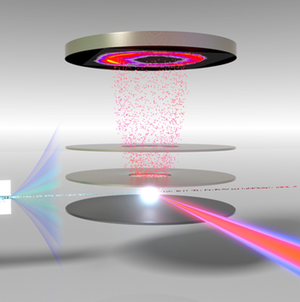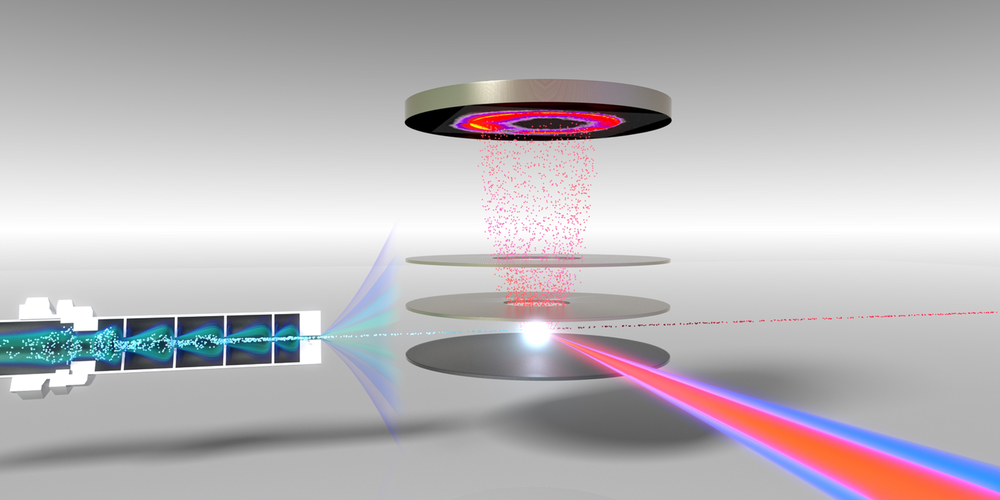The Smallest Shock Wave
Laser pulses can produce an expanding shock wave in a tiny plasma of high-energy ions and electrons, according to work reported in Physical Review Letters. The researchers used a sequence of two laser pulses—one to vaporize a nanoparticle into a plasma and a second to generate the shock wave. Such “nanoplasmas” have been seen before, but this is the first time that researchers have observed a shock wave as it propagates through a nanoplasma. The discovery might ultimately lead to methods for producing ion beams for biomedical uses and could provide insights into other shock phenomena such as shock waves in supernovae.
High-energy particles in the mega-electron-volt range have been produced recently using only moderately intense lasers to generate nanoplasmas—tiny clouds of energetic ions and electrons. Nanoplasmas might ultimately allow researchers to produce high-energy particles without a particle accelerator, says Daniel Hickstein of the University of Colorado in Boulder. And since particles in a nanoplasma shock wave would have a narrow range of energies—a requirement for medical diagnostics and irradiation—creating such shocks could be a first step toward these medical uses.
Hickstein and his colleagues produced nanoplasma shock waves using a system that allows an unprecedented view of the rapidly expanding plasma. The researchers sent a beam of nanoparticles made from sodium chloride, potassium chloride, and other salts, into a vacuum chamber where they were illuminated with tightly focused, 40-femtosecond pulses of violet laser light. About one pulse in every 40 hit a nanoparticle and transformed it into a plasma of ions and electrons. After the plasma had time to expand, the positive ions were drawn up through the centers of two washer-shaped electrodes above the beam and guided to a detector, which measured the particles’ energies.
The energies of the ions ejected from the plasma were not very high compared with other nanoplasma techniques that use smaller nanoparticles and more intense lasers. But the system allowed the team to record the complete energy spectrum of each nanoplasma individually, rather than averaging many together. These energy spectra showed that the intense laser pulses produced shock waves in some of the nanoplasmas, identified by ions clustered into a narrow energy band. The team found that by using a second laser pulse of near infrared light to heat the nanoplasma abruptly, they could create a much stronger shock wave.
But these strong shocks only appeared if the time delay between the first and second pulses was at least 7 picoseconds—long enough for the plasma to expand (increasing its ability to absorb laser light) before the second pulse arrived. According to the team’s calculations, the shock wave is formed as the second pulse is absorbed in a shell of the material, sending a pressure wave into the middle of the plasma that bounces back as an outward-moving shock composed of ions with essentially identical energies.
“Experimentalists have been looking for these shock waves for the past decade, but they have not found them,” says Hickstein. In 2003 a team proposed that nanoplasma shock waves could lead to many interesting effects, including a method to achieve nuclear fusion between ions in a nanoplasma [1]. Hickstein says his team succeeded because they used 100-nanometer-sized particles, 20 times larger than previous experiments. “The larger particle size lets us probe a single nanoparticle at a time,” which he says is crucial for observing the shock wave. With many nanoplasmas averaged together, as in other experiments, the shock would be blurred by the variability among different nanoplasmas.
“The control and imaging of the dynamics of a single nanoplasma is a critical experimental achievement,” says Luis Silva, a plasma physicist at the Instituto Superior Técnico in Lisbon, Portugal. “It opens several avenues for exploration—on the dynamics of these nanoplasmas themselves and on the dynamics of spherical shock waves present in many laboratory and astrophysical phenomena.”
Thomas Fennel of the University of Rostock in Germany cautions that a shock wave may not be the only explanation for the data. “Future theory studies that resolve the different atomic species will show if the interpretation is correct,” he says.
Hickstein stresses that the current results remain a long way from what is required for potential medical uses, and in any event, much fundamental work needs to be done first. “In the short term, we need to gain a better understanding of how exploding nanoplasmas behave and how we can control them,” Hickstein says.
–Philip Ball
Philip Ball is a freelance science writer in London. His latest book is How Life Works (Picador, 2024).
References
- A. E. Kaplan, B. Y. Dubetsky, and P. L. Shkolnikov, “Shock Shells in Coulomb Explosions of Nanoclusters,” Phys. Rev. Lett. 91, 143401 (2003)





